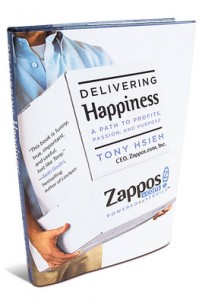Seems like nothing, right? I mean, what could a 1958 military science fiction classic have to do with a 2010 corporate memoir?
Yet when I read Tony Hsieh’s examination of his own company’s culture, especially its hiring practices, I couldn’t help but think of Robert A. Heinlein’s fictional autobiography of a powered armour soldier.
Would you like to know more?
Okay, okay. I’m sorry. I just had to say it.

I think mentioning how Delivering Happiness caught my eye will give this article come context. I bought it at a book clearance sale last week while looking for a nice police procedural thriller that’d get me back in the good books with my lady wife after a lack of tact. I found one, but whilst browsing, the logo of a company called Zappos caught my eye.
In my last post I mentioned an episode of Freakonomics Radio that discussed, of all things, the upside quitting. In it, host Stephen Dubner mentions an online shoe retail company called Zappos that actually offers new employees two thousand dollars to quit before the four-week (paid) training period ends. And though they make good on their offer, surprisingly few take it
Look, I’ll let Dubner lay the figures out. Go download that podcast and have a listen. It’s very interesting subject material presented in an entertaining manner.
So not a week after listening to that podcast, I find a book about the very same company it mentioned, written by its chief executive officer, Tony Hsieh. Odd little bit of serendipity, eh? It had my honest interest and was cheap enough that I couldn’t argue myself out buying it. I was curious about this company that offers its new employees two grand to part ways with the company on top of what it paid them in their one-month trial.
And it’s a great little read. Author Tony Hsieh might call himself a novice but although I’d polish his text a little here and there, he’s a very entertaining writer. He filters his life both prior to the founding of Zappos and during his ongoing leadership of it through twin lenses of finding creative ways to make money and fostering good times with people. Indeed, one of the first major down-turns in Tony’s business fortune happened around when a firm he was running become so big that he didn’t know a sizeable portion of the people who worked there.
You know, if you were after an entertaining read I’d be more likely to hand you Delivering Happiness than Starship Troopers. The former might contain some buzz-wordery and management-speak, but the latter is pretty didactic.
But regardless, just what do Starship Troopers and Delivering Happiness have in common?
Well, when I read about Tony’s history with the company and the $2,000-to-quit option (which is actually a small part of the book), I kept thinking of model of federal service Heinlein introduced in Starship Troopers. It’s not the “Service Guarantees Citizenship” deal (yeah, I know, I mentioned the movie again) so much as the fact that servicemen and women can quit the service at any time (and we’re back in Freakonomics territory again), but only once, with no chance to rejoin.

I read the novel Starship Troopers after watching the movie and I remember the text confusing me; everything the movie lampooned, the book seemed to advocate. It was that whole Federal Service thing that was the biggest lump to swallow. Even though the character of Major Reid pretty much spells out the point of it later in the book it still took a while for me to process, especially as Reid was rather flowery in laying it out.
Aside from the moral argument of the power to decide who has control of a nation, from its welfare mechanisms to its military disposition, being given to those who’ve demonstrated some moral awareness, I see the service route to citizenship as filtering out the kind of person who’ll make a vote based on what will make their personal existence the most comfortable – they already passed comfort (even safety) up for the duration of their arduous service. They’re more likely to be the kind who’ll continue to serve once their technical service period is over (if they survive, of course) and less likely to be bribed or otherwise coerced into voting the easy option.
How does this extreme relate to Zappos? From what I gather from both “The Upside of Quitting” and Delivering Happiness, Zappos seems like a great place to work; its core offering is customer service, no matter what the actual product on offer is, and everyone, from Hsieh to entry-level trainees, seems committed to removing as many impediments from providing that service as possible (see the previous comment about Tony Hsieh’s interest in fostering good times). They create and maintain a culture that nurtures friendship amongst its employees and encourages them to look out for each other. Even the rounds of layoffs when the global economy tanked in 2008 seem to have been handled as maturely and responsibly as possible.
Part of that is the $2,000 offer. That’s no small chunk of change, even in times as work-challenged as ours, enough to give you a few more weeks’ buffer while you look for other options. It also encourages trainees to examine any misgivings they may have about the company and its way of operating. Those who honestly don’t like how Zappos rolls after seeing it from the inside know that they won’t be penalised for going, while those who just decide to take the money because, hey, easy two grand aren’t the kind Zappos (or any company that has priorities other than Make as Much Money as Possible) would want on board.
Ideally, the rest are the kind who will dig the Zappos approach – which, from what I’ve read and heard, seems like it makes a great company to work for.
The cynic in me is quick to point out that history is written by the winners, and this chronicle of the founding, growth and success of Zappos is written by the CEO. Stephen Dubner also points out how passing up that $2,000 can actually help an employee talk him- or herself into staying when quitting may be the better option for that that employee (“I passed up 2,000 to stay, so I must love the company, right?”).
Yet Tony is disarmingly honest about all his missteps, up to and including the times when he had to lay staff off. And how can you not admire a CEO willing to buy his board of directors out so he could ensure his company didn’t go straight after maximum profits?
So what do a military science fiction classic and a corporate memoir have in common? In their own unique ways, each is an examination of what “living a good life” is, even in such different contexts. They’re both about not taking the short-term, easy way out, even if you don’t realise exactly why the hard way’s the better one right now.
Let me leave you with odd paradox: While Starship Troopers got a movie some forty years after it was published, I think Delivering Happiness got its movie some fourteen years before it was published:
Jerry Maguire.
(Is it really fifteen years since it came out? Where the hell did the time go?)
